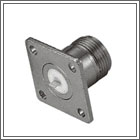y7wu
Newbie level 6
loss tangent smith chart
Hi, I have been designing a Class F amplifier with harmonic output matching network. The output matching is done on a Rogers RT/duroid 5870/5880 substrate, which according to the datasheet has a loss tangent of 0.0005 at 1Mhz and 0.00012 at 10GHz.
I entered the substrate info into ADS and did my design, both circuit simulation and momentum showed that at harmonic frequency the impedance looking into the output matching network is at the edge of the smith chart (i.e open circuit/close circuit)
However, when I fabricated the circuit and did the impedance measurement
I can never seem to get right at the edge of the smith chart. The best I could do is around 0.9, not the 0.96 to 1.00 indicated by simulation. I believe this has caused me to obtain lower efficiency for my class F PA.
What is the source of the discrepency?
I was thinking perhaps there is more substrate loss than expected?
Radiation?
Insertion loss (I have 1 ATC DC blocking cap)?
Equipment Calibration ?(I use PNA-X with E-Cal and good cables)
How can I debug this issue?
Is it unreasonable to expect impedance to be very close to the edge of the smith chart?
Thank you for your response.
Hi, I have been designing a Class F amplifier with harmonic output matching network. The output matching is done on a Rogers RT/duroid 5870/5880 substrate, which according to the datasheet has a loss tangent of 0.0005 at 1Mhz and 0.00012 at 10GHz.
I entered the substrate info into ADS and did my design, both circuit simulation and momentum showed that at harmonic frequency the impedance looking into the output matching network is at the edge of the smith chart (i.e open circuit/close circuit)
However, when I fabricated the circuit and did the impedance measurement
I can never seem to get right at the edge of the smith chart. The best I could do is around 0.9, not the 0.96 to 1.00 indicated by simulation. I believe this has caused me to obtain lower efficiency for my class F PA.
What is the source of the discrepency?
I was thinking perhaps there is more substrate loss than expected?
Radiation?
Insertion loss (I have 1 ATC DC blocking cap)?
Equipment Calibration ?(I use PNA-X with E-Cal and good cables)
How can I debug this issue?
Is it unreasonable to expect impedance to be very close to the edge of the smith chart?
Thank you for your response.
